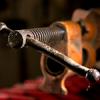I use King, 800, 1200 and 6000 grit stones to hone, and the larger Tormek to produce a hollow grind. My honing results are OK, and I can get a chisel or plane blade sharp enough to shave or push into a paper edge. I'm not sure these two tests are really the best test for sharpness, and am wondering if I would get much benefit going to an 8000 stone? And maybe a stone in between the 1200 and 6000, like a 4000, which would have me at 1200, 4000, and 8000. Any thoughts on this will be appreciated.




 Reply With Quote
Reply With Quote








